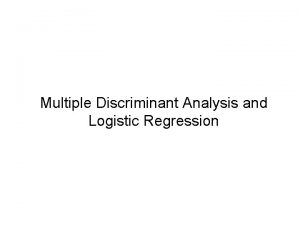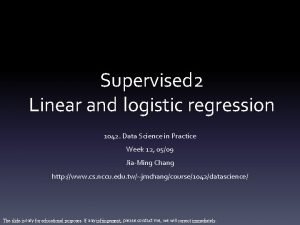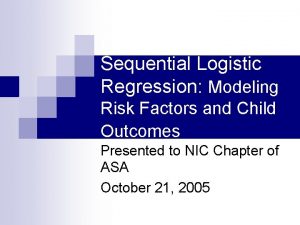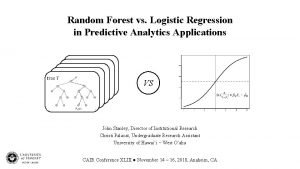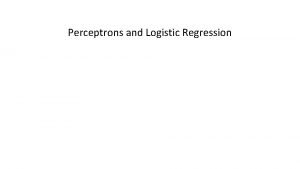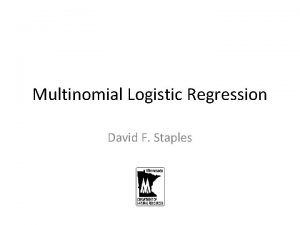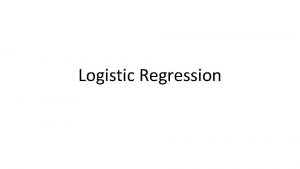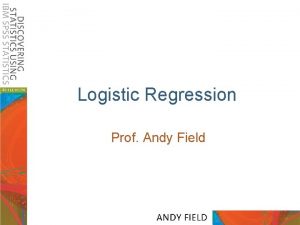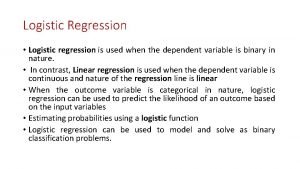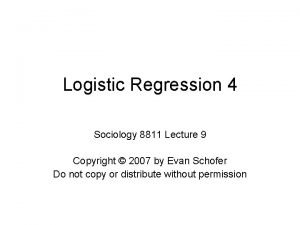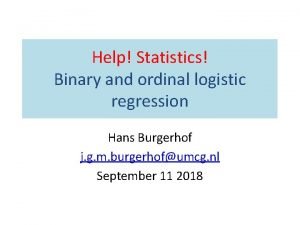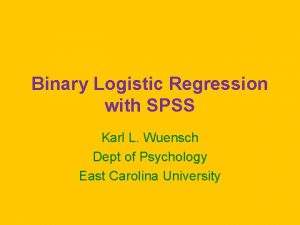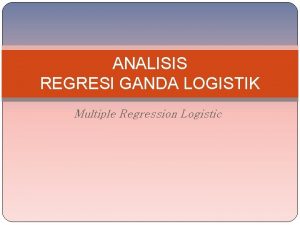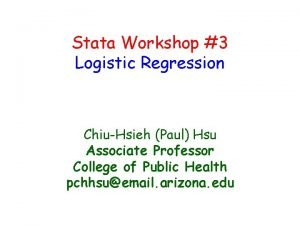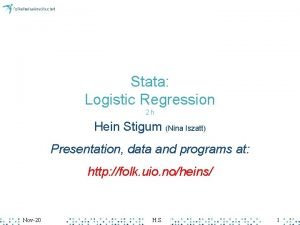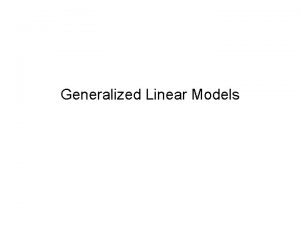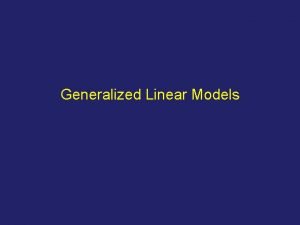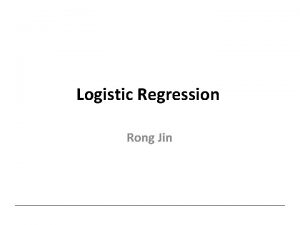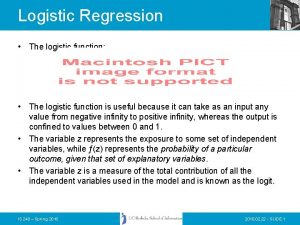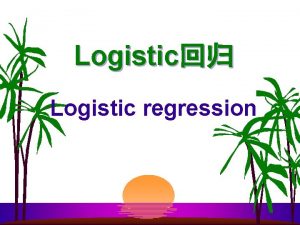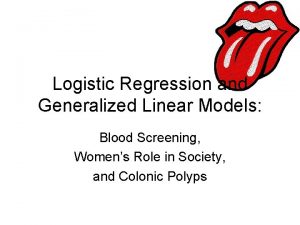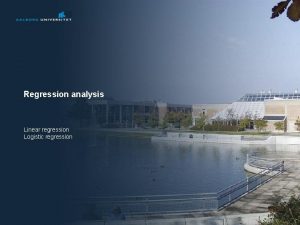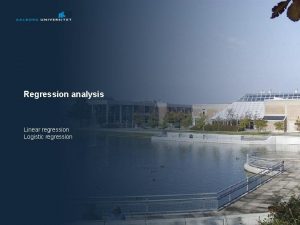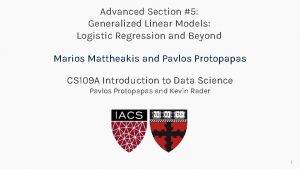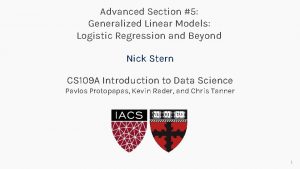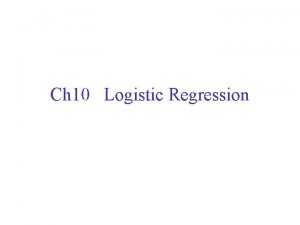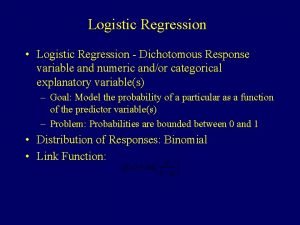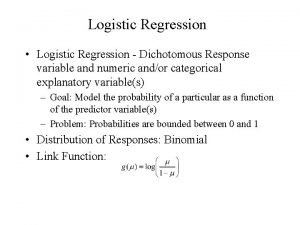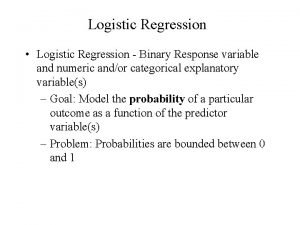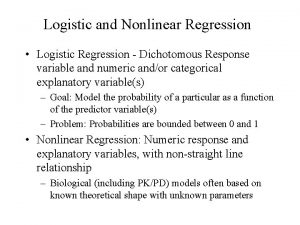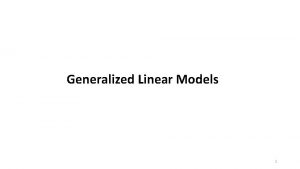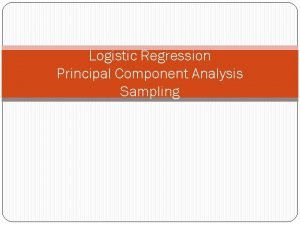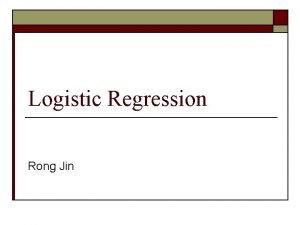Introduction to logistic regression and Generalized Linear Models




















- Slides: 20

Introduction to logistic regression and Generalized Linear Models Karen Bandeen-Roche, Ph. D Department of Biostatistics Johns Hopkins University July 14, 2011 Introduction to Statistical Measurement and Modeling

Data motivation v Osteoporosis data v Scientific question: Can we detect osteoporosis earlier and more safely? v Some related statistical questions: v How does the risk of osteoporosis vary as a function of measures commonly used to screen for osteoporosis? v Does age confound the relationship of screening measures with osteoporosis risk? v Do ultrasound and DPA measurements discriminate osteoporosis risk independently of each other?

Outline v Why we need to generalize linear models v Generalized Linear Model specification v Systematic, random model components v Maximum likelihood estimation v Logistic regression as a special case of GLM v Systematic model / interpretation v Inference v Example

v Regression for categorical outcomes Why not just apply linear regression to categorical Y’s? v Linear model (A 1) will often be unreasonable. v Assumption of equal variances (A 3) will nearly always be unreasonable. v Assumption of normality will never be reasonable

Introduction: Regression for binary outcomes v Yi = 1{event occurs for sampling unit i} = 1 if the event occurs = 0 otherwise. v pi = probability that the event occurs for sampling unit i : = Pr{Yi = 1} v Begin by generalizing random model (A 5): v Probability mass function: Bernoulli Pr{Yi = 1} = pi; Pr{Yi = 0} = 1 -pi all other yi occur with 0 probability

Binary regression v By assuming Bernoulli: (A 3) is definitely not reasonable v Var(Yi ) = pi(1 -pi) v Variance is not constant: rather a function of the mean v Systematic model v Goal remains to describe E[Yi|xi] v Expectation of Bernoulli Yi = pi v To achieve a reasonable linear model (A 1): describe some function of E[Yi|xi] as a linear function of covariates v g(E[Yi|xi]) = xi’β v Some common g: log, log{p/(1 -p)}, probit

General framework: Generalized Linear Models v Random model v Y~a density or mass function, f. Y, not necessarily normal v Technical aside: f. Y within the “exponential family” v Systematic model v g(E[Yi|xi]) = xi’β = ηi v “g” = “link function”; “xi’β” = “linear predictor” v Reference: Nelder JA, Wedderburn RWM, Generalized linear models, JRSSA 1972; 135: 370 -384.

Types of Generalized Linear Models Model (link function) Linear Logistic Log-linear Proportional hazards Response Distribution Regression Coef Interp Continuous Gaussian Change in ave(Y) per unit change in X Binary Binomial Log odds ratio Times to events/counts Poisson Log relative rate Times to events Semiparametric Log hazard

Estimation v Estimation: maximizes L(β, a; y, X) = v General method: Maximum likelihood (Fisher) v Given {Y 1, . . . , Yn} distributed with joint density or mass function f. Y(y; θ), a likelihood function L(θ; y) is any function (of θ) that is proportional to f. Y(y; θ). v If sampling is random, {Y 1, . . . , Yn} are statistically independent, and L(θ; y) α product of individual f.

Maximum likelihood v The maximum likelihood estimate (MLE), , maximizes L(θ; y): v Under broad assumptions MLEs are asymptotically v Unbiased (consistent) v Efficient (most precise / lowest variance)

Logistic regression v Yi binary with pi = Pr{Yi = 1} v Example: Yi = 1{person i diagnosed with heart disease} v Simple logistic regression (1 covariate) v Random Model: Bernoulli / Binomial v Systematic Model: log{pi/(1 - pi)}= β 0 + β 1 xi v log odds; logit(pi) v Parameter interpretation v β 0 = log(heart disease odds) in subpopulation with x=0 v β 1 = log{px+1/(1 -px+1)}- log{px/(1 -px)}

Logistic regression Interpretation notes v β 1 = log{px+1/(1 -px+1)}- log{px/(1 -px)} = v exp(β 1) = = odds ratio for association of prevalent heart disease with each (say) one year increment in age = factor by which odds of heart disease increases / decreases with each 1 -year cohort of age

Multiple logistic regression v Systematic Model: log{pi/(1 - pi)}= β 0 + β 1 xi 1 + … + βpxip v Parameter interpretation v β 0 = log(heart disease odds) in subpopulation with all x=0 v βj = difference in log outcome odds comparing subpopulations who differ by 1 on xj, and whose values on all other covariates are the same v “Adjusting for, ” “Controlling for” the other covariates v One can define variables contrasting outcome odds differences between groups, nonlinear relationships, interactions, etc. , just as in linear regression

Logistic regression - prediction v Translation from ηi to pi v log{pi/(1 - pi)}= β 0 + β 1 xi 1 + … + βpxip v Then = logistic function of ηi v Graph of pi versus ηi has a sigmoid shape

GLMs - Inference v The negative inverse Hessian matrix of the log likelihood function characterizes Var( ) (adjunct) v SE( ) obtained as square root of the jth diagonal entry v Typically, substituting for β v “Wald” inference applies the paradigm from Lecture 2 v Z= β 0 j is asympotically ~ N(0, 1) under H 0: βj= v Z provides a test statistic for H 0: βj= β 0 j versus HA: βj≠ β 0 j v ± z(1 -α/2) SE{ } =(L, U) is a (1 -α)x 100% CI for βj v {exp(L), exp(U)} is a (1 -α)x 100% CI for exp(βj)

GLMs: “Global” Inference v Analog: F-testing in linear regression v The only difference: log likelihoods replace SS v Hypothesis to be tested is H 0: βj 1=. . . =βjk = 0 v Fit model excluding xj 1, . . . , xjpj: Save -2 log likelihood = Ls v Fit “full” (or larger) model adding xj 1, . . . , xjpj to smaller model. Save -2 log likelihood = LL v Test statistic S = Ls - LL v Distribution under null hypothesis: χ2 pj v Define rejection region based on this distribution v Compute S v Reject or not as S is in rejection region or not

GLMs: “Global” Inference v Many programs refer to “deviance” rather than -2 log likelihood v This quantity equals the difference in -2 log likelihoods between ones fitted model and a “saturated model” v Deviance measures “fit” v Differences in deviances can be substituted for differences in -2 log likelihood in the method given on the previous page v Likelihood ratio tests have appealing optimality properties

Outline: A few more topics v Model checking: Residuals, influence points v ML can be written as an iteratively reweighted least squares algorithm v Predictive accuracy v Framework generalizes easily

Main Points v Generalized linear modeling provides a flexible regression framework for a variety of response types v Continuous, categorical measurement scales v Probability distributions tailored to the outcome v Systematic model to accommodate v Measurement range, interpretation v Logistic regression v Binary responses (yes, no) v Bernoulli / binomial distribution v Regression coefficients as log odds ratios for association between predictors and outcomes

Main Points v Generalized linear modeling accommodates description, inference, adjustment with the same flexibility as linear modeling v Inference v “Wald”- statistical tests and confidence intervals via parameter estimator standardization v “Likelihood ratio” / “global” – via comparison of log likelihoods from nested models
 Survival analysis vs logistic regression
Survival analysis vs logistic regression Logistic regression vs linear regression
Logistic regression vs linear regression Linear regression vs multiple regression
Linear regression vs multiple regression Regression linear model
Regression linear model Logistic regression and discriminant analysis
Logistic regression and discriminant analysis Logistic regression residual deviance
Logistic regression residual deviance Sequential logistic regression
Sequential logistic regression Logistic regression vs random forest
Logistic regression vs random forest Perceptron
Perceptron Multinomial logistic regression
Multinomial logistic regression Cost function logistic regression
Cost function logistic regression Andy field regression
Andy field regression Logistic regression
Logistic regression Multinomial logistic regression
Multinomial logistic regression Logistic regression epidemiology
Logistic regression epidemiology Binary
Binary Logistic regression spss output
Logistic regression spss output Regresi logistik berganda adalah
Regresi logistik berganda adalah Logistic regression stata
Logistic regression stata Logistic regression stata
Logistic regression stata Multiple linear regression
Multiple linear regression




